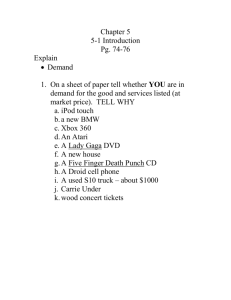Document
advertisement
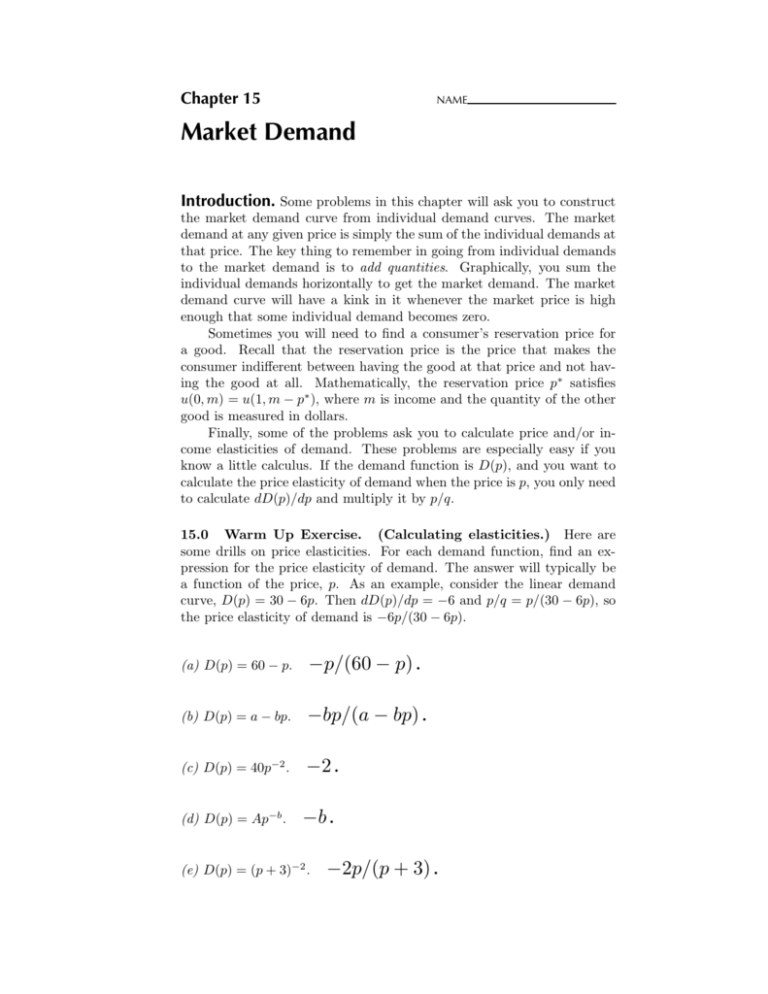
Chapter 15
NAME
Market Demand
Introduction. Some problems in this chapter will ask you to construct
the market demand curve from individual demand curves. The market
demand at any given price is simply the sum of the individual demands at
that price. The key thing to remember in going from individual demands
to the market demand is to add quantities. Graphically, you sum the
individual demands horizontally to get the market demand. The market
demand curve will have a kink in it whenever the market price is high
enough that some individual demand becomes zero.
Sometimes you will need to find a consumer’s reservation price for
a good. Recall that the reservation price is the price that makes the
consumer indifferent between having the good at that price and not having the good at all. Mathematically, the reservation price p∗ satisfies
u(0, m) = u(1, m − p∗ ), where m is income and the quantity of the other
good is measured in dollars.
Finally, some of the problems ask you to calculate price and/or income elasticities of demand. These problems are especially easy if you
know a little calculus. If the demand function is D(p), and you want to
calculate the price elasticity of demand when the price is p, you only need
to calculate dD(p)/dp and multiply it by p/q.
15.0 Warm Up Exercise. (Calculating elasticities.) Here are
some drills on price elasticities. For each demand function, find an expression for the price elasticity of demand. The answer will typically be
a function of the price, p. As an example, consider the linear demand
curve, D(p) = 30 − 6p. Then dD(p)/dp = −6 and p/q = p/(30 − 6p), so
the price elasticity of demand is −6p/(30 − 6p).
(a) D(p) = 60 − p.
−p/(60 − p).
(b) D(p) = a − bp.
−bp/(a − bp).
(c) D(p) = 40p−2 .
−2.
(d) D(p) = Ap−b .
−b.
(e) D(p) = (p + 3)−2 .
−2p/(p + 3).
192
MARKET DEMAND
(f ) D(p) = (p + a)−b .
(Ch. 15)
−bp/(p + a).
15.1 (0) In Gas Pump, South Dakota, there are two kinds of consumers,
Buick owners and Dodge owners. Every Buick owner has a demand function for gasoline DB (p) = 20 − 5p for p ≤ 4 and DB (p) = 0 if p > 4.
Every Dodge owner has a demand function DD (p) = 15 − 3p for p ≤ 5
and DD (p) = 0 for p > 5. (Quantities are measured in gallons per week
and price is measured in dollars.) Suppose that Gas Pump has 150 consumers, 100 Buick owners, and 50 Dodge owners.
(a) If the price is $3, what is the total amount demanded by each individual Buick Owner?
5.
And by each individual Dodge owner?
6.
(b) What is the total amount demanded by all Buick owners?
What is the total amount demanded by all Dodge owners?
500.
300.
(c) What is the total amount demanded by all consumers in Gas Pump
at a price of 3?
800.
(d) On the graph below, use blue ink to draw the demand curve representing the total demand by Buick owners. Use black ink to draw the
demand curve representing total demand by Dodge owners. Use red ink
to draw the market demand curve for the whole town.
(e) At what prices does the market demand curve have kinks?
At
p = 4 and p = 5.
(f ) When the price of gasoline is $1 per gallon, how much does weekly
demand fall when price rises by 10 cents?
65 gallons.
(g) When the price of gasoline is $4.50 per gallon, how much does weekly
demand fall when price rises by 10 cents?
15 gallons.
(h) When the price of gasoline is $10 per gallon, how much does weekly
demand fall when price rises by 10 cents?
Remains at zero.
NAME
193
Dollars per gallon
6
5
4
3
Blue line
2
Red line
1
Black
line
0
500
1000
1500
2000
2500
3000
Gallons per week
15.2 (0) For each of the following demand curves, compute the inverse
demand curve.
(a) D(p) = max{10 − 2p, 0}.
√
(b) D(p) = 100/ p.
p(q) = 5 − q/2 if q < 10.
p(q) = 10, 000/q 2 .
p(q) = (10 − ln q)/4.
(d) ln D(p) = ln 20 − 2 ln p. p(q) =
20/q.
(c) ln D(p) = 10 − 4p.
15.3 (0) The demand function of dog breeders for electric dog polishers
is qb = max{200−p, 0}, and the demand function of pet owners for electric
dog polishers is qo = max{90 − 4p, 0}.
(a) At price p, what is the price elasticity of dog breeders’ demand for
electric dog polishers?
of pet owners’ demand?
−p/(200 − p).
What is the price elasticity
−4p/(90 − 4p).
NAME
195
Price
300
250
200
150
100
Blue line
50
Pencil line
22.5
Red
line
90
100
50
0
150
200
250
290
300
Quantity
Calculus
15.4 (0) The demand for kitty litter, in pounds, is ln D(p) = 1, 000 −
p + ln m, where p is the price of kitty litter and m is income.
(a) What is the price elasticity of demand for kitty litter when p = 2 and
m = 500?
m = 1, 500?
−2.
When p = 3 and m = 500?
−3.
When p = 4 and
−4.
(b) What is the income elasticity of demand for kitty litter when p = 2
and m = 500?
1.
When p = 3 and m = 1, 500?
When p = 2 and m = 1, 000?
1.
1.
196
MARKET DEMAND
(Ch. 15)
(c) What is the price elasticity of demand when price is p and income is
m?
Calculus
−p.
The income elasticity of demand?
1.
15.5 (0) The demand function for drangles is q(p) = (p + 1)−2 .
(a) What is the price elasticity of demand at price p?
−2p/(p+1).
(b) At what price is the price elasticity of demand for drangles equal to
−1?
When the price equals 1.
(c) Write an expression for total revenue from the sale of drangles as
R(p) = pq = p/(p + 1)2 . Use
a function of their price.
calculus to find the revenue-maximizing price. Don’t forget to check the
second-order condition.
Differentiating and solving
gives p = 1.
(d) Suppose that the demand function for drangles takes the more general
form q(p) = (p + a)−b where a > 0 and b > 1. Calculate an expression for
the price elasticity of demand at price p.
−bp/(p + a).
price is the price elasticity of demand equal to −1?
At what
p = a/(b − 1).
15.6 (0) Ken’s utility function is uK (x1 , x2 ) = x1 + x2 and Barbie’s
utility function is uB (x1 , x2 ) = (x1 + 1)(x2 + 1). A person can buy 1
unit of good 1 or 0 units of good 1. It is impossible for anybody to buy
fractional units or to buy more than 1 unit. Either person can buy any
quantity of good 2 that he or she can afford at a price of $1 per unit.
(a) Where m is Barbie’s wealth and p1 is the price of good 1, write an
equation that can be solved to find Barbie’s reservation price for good 1.
(m − p1 + 1)2 = m + 1.
What is Barbie’s reservation price
p = (m + 1)/2.
What is Ken’s reservation price for
for good 1?
good 1?
$1.
(b) If Ken and Barbie each have a wealth of 3, plot the market demand
curve for good 1.
NAME
197
Price
4
3
2
1
0
1
2
3
4
Quantity
1
15.7 (0) The demand function for yo-yos is D(p, M ) = 4 − 2p + 100
M,
where p is the price of yo-yos and M is income. If M is 100 and p is 1,
1/3.
(a) What is the income elasticity of demand for yo-yos?
(b) What is the price elasticity of demand for yo-yos?
−2/3.
15.8 (0) If the demand function for zarfs is P = 10 − Q,
(a) At what price will total revenue realized from their sale be at a maximum?
P = 5.
(b) How many zarfs will be sold at that price?
Q = 5.
15.9 (0) The demand function for football tickets for a typical game at a
large midwestern university is D(p) = 200, 000 − 10, 000p. The university
has a clever and avaricious athletic director who sets his ticket prices so
as to maximize revenue. The university’s football stadium holds 100,000
spectators.
(a) Write down the inverse demand function.
q/10, 000.
p(q) = 20 −
198
MARKET DEMAND
(Ch. 15)
(b) Write expressions for total revenue
and marginal revenue
number of tickets sold.
R(q) = 20q−q 2 /10, 000
MR = 20 − q/5, 000
as a function of the
(c) On the graph below, use blue ink to draw the inverse demand function
and use red ink to draw the marginal revenue function. On your graph,
also draw a vertical blue line representing the capacity of the stadium.
Price
30
Red line
25
Stadium capacity
20
Black line
15
Blue line
10
5
Red line
0
20
40
60
80
100
120
140
160
Quantity x 1000
(d) What price will generate the maximum revenue?
quantity will be sold at this price?
$10.
What
100,000.
(e) At this quantity, what is marginal revenue?
what is the price elasticity of demand?
−1.
0.
At this quantity,
Will the stadium be full?
Yes.
(f ) A series of winning seasons caused the demand curve for football
tickets to shift upward. The new demand function is q(p) = 300, 000 −
10, 000p. What is the new inverse demand function?
q/10, 000.
p(q) = 30 −
NAME
199
(g) Write an expression for marginal revenue as a function of output.
M R(q) = 30 − q/5, 000. Use red ink to draw the new demand
function and use black ink to draw the new marginal revenue function.
(h) Ignoring stadium capacity, what price would generate maximum
revenue?
$15.
What quantity would be sold at this price?
150,000.
(i) As you noticed above, the quantity that would maximize total revenue
given the new higher demand curve is greater than the capacity of the
stadium. Clever though the athletic director is, he cannot sell seats he
hasn’t got. He notices that his marginal revenue is positive for any number
of seats that he sells up to the capacity of the stadium. Therefore, in order
to maximize his revenue, he should sell
of
100,000
tickets at a price
$20.
(j) When he does this, his marginal revenue from selling an extra seat
is
10.
The elasticity of demand for tickets at this price quantity
combination is
= −2.
15.10 (0) The athletic director discussed in the last problem is considering the extra revenue he would gain from three proposals to expand the
size of the football stadium. Recall that the demand function he is now
facing is given by q(p) = 300, 000 − 10, 000p.
(a) How much could the athletic director increase the total revenue per
game from ticket sales if he added 1,000 new seats to the stadium’s capacity and adjusted the ticket price to maximize his revenue?
9,900.
(b) How much could he increase the revenue per game by adding 50,000
new seats?
$250,000.
60,000 new seats? (Hint: The athletic
director still wants to maximize revenue.)
$250,000.
(c) A zealous alumnus offers to build as large a stadium as the athletic
director would like and donate it to the university. There is only one hitch.
The athletic director must price his tickets so as to keep the stadium full.
If the athletic director wants to maximize his revenue from ticket sales,
how large a stadium should he choose?
150,000 seats.
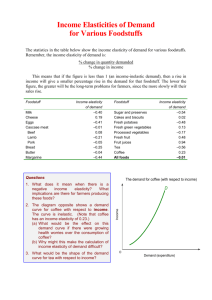
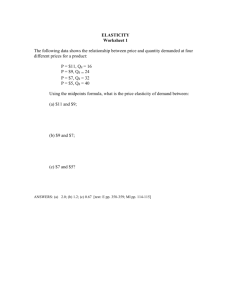
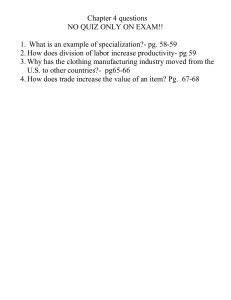

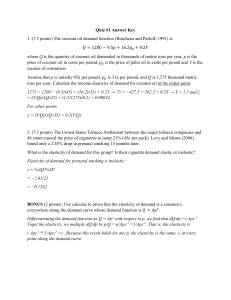
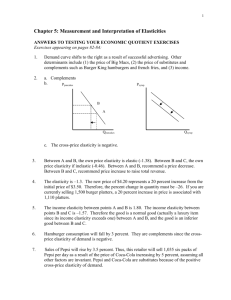

![Problem Set 2 Answer Key 1) = [ (600-500) / 500 ] / [ (7,5](http://s3.studylib.net/store/data/007545927_2-a14d6cb799111def938fd71314890ee2-300x300.png)
